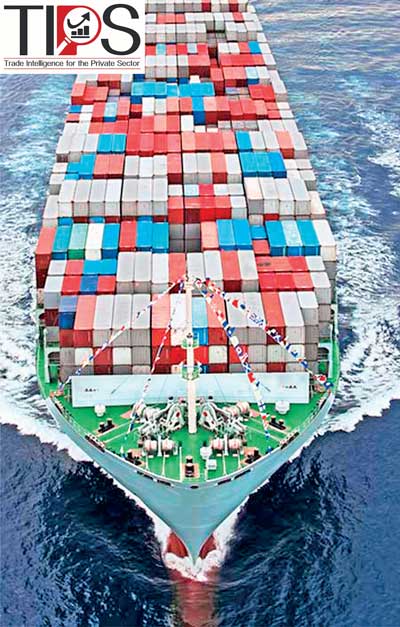13 Oct 2016 - {{hitsCtrl.values.hits}}
By Anushka Wijesinha
The global spotlight on exports falls on Sri Lanka this week with World Export Development Forum (WEDF) 2016 taking place in Colombo. At the official opening of WEDF 2016, Prime Minister Ranil Wickremesinghe reiterated that the government is now refocusing on exports. His remarks come at an important point, when exports have declined rather alarmingly. It is timely to take a snapshot of the country’s recent export performance and highlight some key areas to refocus our attention on to boost exports.

Recent export performance
According to the latest trade data, Sri Lanka’s exports in the first half of this year were down 6 percent against the same period last year, which is a rather alarming decline.
For the month of June, which is the most recent available month, the exports declined by 5 percent year-on-year (YoY) (already on the back of low exports last year). Meanwhile, for the same month, the imports increased by 2.6 percent YoY, part of a steady uptick seen since April. As a result, the trade deficit increased by 13 percent YoY in June, even though for the first six months ending June, it is 5 percent lower than the same period last year.
In the first half of this year, the export earnings covered only 55 out of every 100 dollars spent on imports. Earnings from tourism and worker remittances continue to contribute strongly to forex earnings and act as a vital buffer against the declining export earnings. Forty out of every 100 dollars spent on imports were covered by worker remittances and 20 out of every 100 dollars of imports were covered by tourism receipts.
External side: Oil bill breathing space ending?
The secular decline in exports comes at a time when Sri Lanka has enjoyed the benefits of a lower oil import bill. The oil prices were low throughout 2015 and early 2016 (as low as US $ 26 a barrel in February). This has been a much-needed relief on the external balances side. In the first half of 2016, Sri Lanka’s oil import bill was more than a half lower than in 1H 2014 and nearly one-fourth lower than in 1H 2015. As a share of total imports, the oil imports were 13 percent in 1H 2016, compared to 27 percent in 1H 2014 and 18 percent in 1H 2015.
This breathing space may not last for long. At a meeting last month, the oil cartel Organisation of Petroleum Exporting Countries (OPEC) agreed to cut the oil output by around 700,000 barrels per day in order to shore up prices. Moreover, just this week, Russian premier Putin indicated that Russia too may join the output cut, adding further upward pressure on prices. Against a backdrop of declining export revenue, a likely increase in global oil prices and the impact that would have on our oil import bill, is a critical medium-term risk.
Diagnosing the decline: What should the focus be?
Last week, the Ceylon Chamber of Commerce (CCC) initiated an opinion poll amongst its member companies to ascertain what the key reasons are for the secular decline in Sri Lanka’s exports to gross domestic product (GDP) ratio (from over 30 percent in 2000 to under 13 percent last year). While the poll is still open and the results are still coming in, at the time of writing, the highest ranked issue (27.5 percent) was the ‘Lack of innovation and new products’. A distant second (19.1 percent) was the ‘Rising costs of production’ and in third place (17.6 percent) was ‘Limited entry intro growing/new markets’. Meanwhile, the ‘Lack of government support’ came in fourth, at 14.5 percent.
In identifying the precise next steps to remedy these issues, two documents provide a good starting point. The first is a document titled ‘Recommendations for a National Export Strategy’ developed by the Exporters Association of Sri Lanka, after extensive consultations with the stakeholders in the industry, public sector and academia. The second is a diagnostic and advisory report produced by the World Bank on invitation of the Development Strategies and International Trade Ministry, on ‘Innovation and Entrepreneurship for Export Competitiveness’.
Reversing the slide: Next steps
These, together with the findings of the 2015 Sri Lanka Economic Summit of the CCC, give a clear indication of what a private–public joint strategy for accelerating exports needs to focus on – 1) enhancing innovation through immediate technology transfer programmes and industry-research collaboration to push firms towards technology upgrading and higher value capturing products and services; 2) tackling critical business climate bottlenecks that hurt competitiveness and productivity of exporters, including multiplicity of documentation, burdensome and outdated domestic regulatory systems and coordination failures between government agencies) and 3) fast-tracking bilateral and regional free trade agreements (FTAs) that help exporters gain new and preferential market access.
These are key factors in reversing the export decline, regaining export competitiveness on the world stage and contributing to the economy’s transition from an economy largely driven by basic exports made with cheaper factor inputs to one driven by more sophisticated exports using knowledge-intensity, innovation and participation in global production networks.
(Anushka Wijesinha is Chief Economist of the Ceylon Chamber of Commerce (CCC). This article is part of the ‘Trade Intelligence for the Private Sector’ (TIPS) initiative of the CCC, aimed at enhancing awareness on trade policy issues in the Sri Lankan private sector)
25 Nov 2024 3 hours ago
25 Nov 2024 4 hours ago
25 Nov 2024 4 hours ago
25 Nov 2024 5 hours ago
25 Nov 2024 6 hours ago